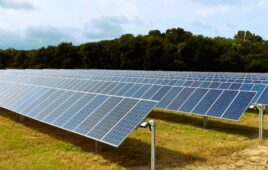The back and forth finally seems to be over. The United States Court of International Trade released its decision today on whether bifacial solar modules should be included again under the Section 201 tariff on imported solar panels.
![]() Judge Gary S. Katzmann decided to revoke bifacial modules’ exemption from the tariffs, and put them back under tax status, effective immediately.
Judge Gary S. Katzmann decided to revoke bifacial modules’ exemption from the tariffs, and put them back under tax status, effective immediately.
This comes after President Trump issued an Executive Order last month recommending an increase in the overall tariff amount and an end to bifacial’s exemption.
The solar industry was the first market to feel the hit of tariffs brought on by Trump in 2018. Beginning in February 2018, imported crystalline silicon cells, modules and AC/integrated modules were tariffed 30% as part of a four-year outline. Imports received a 25% tariff in 2019, a 20% tariff in 2020 and were scheduled for a 15% tariff in 2021. Bifacial modules first received full exemption in June 2019. Today that ends.
All types of imported crystalline silicon solar panels (except for a few minor exemptions) will continue to receive a 20% tariff through February 2021. Trump succeeded in increasing the 2021 tariff amount from 15% to 18%. All imported solar panels will have an 18% tax beginning in February 2021.





“The solar industry was the first market to feel the hit of tariffs brought on by Trump in 2018. Beginning in February 2018, imported crystalline silicon cells, modules and AC/integrated modules were tariffed 30% as part of a four-year outline. Imports received a 25% tariff in 2019, a 20% tariff in 2020 and were scheduled for a 15% tariff in 2021. Bifacial modules first received full exemption in June 2019. Today that ends.”
So, will all of this “feverish” Presidential Executive Order generation be naught when Joe Biden takes over? Will Joe and his team decide to “let it slide” until a “good word” during the Pandemic signals, rejoining society as we did before March of 2019? For 2021 there will still be an ITC of 22% for solar PV installations and energy storage systems. Because smart energy storage systems are still relatively expensive, it might be a good idea to “at least” purchase and install smart energy storage in one’s home and use the ITC of 22% to reduce the overall cost of the system, then if the budget and tariffs allow, install solar PV later on your roof.